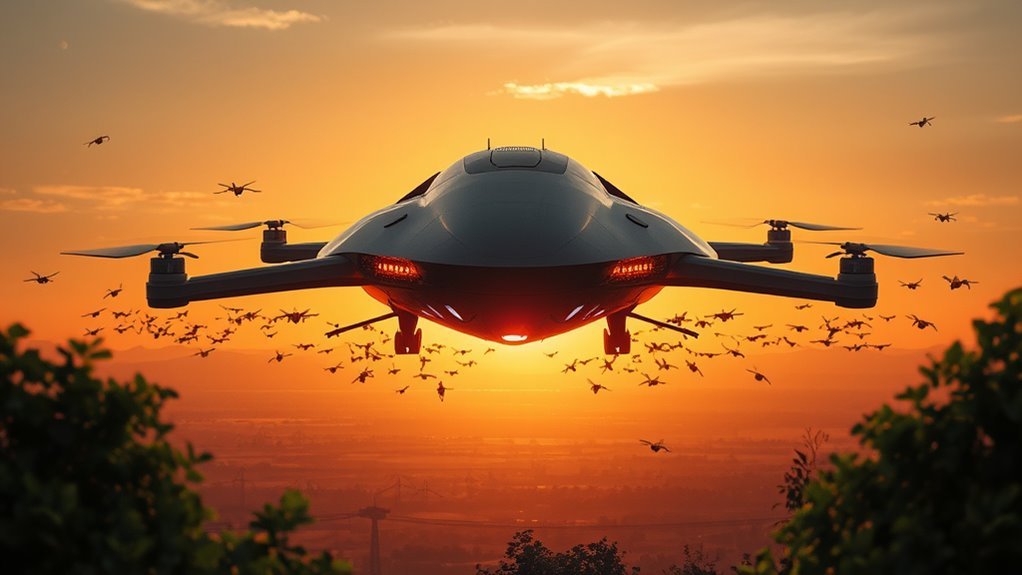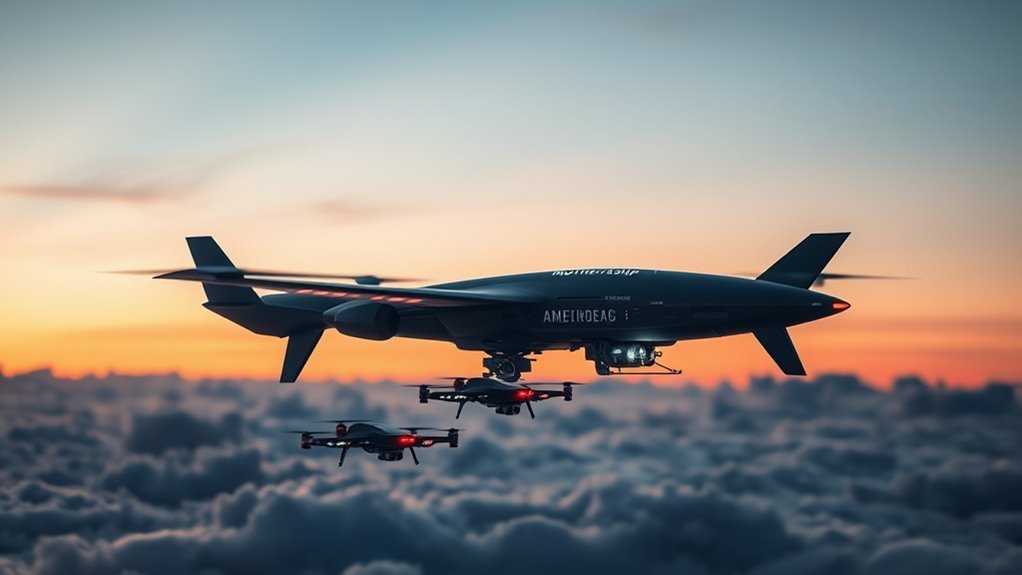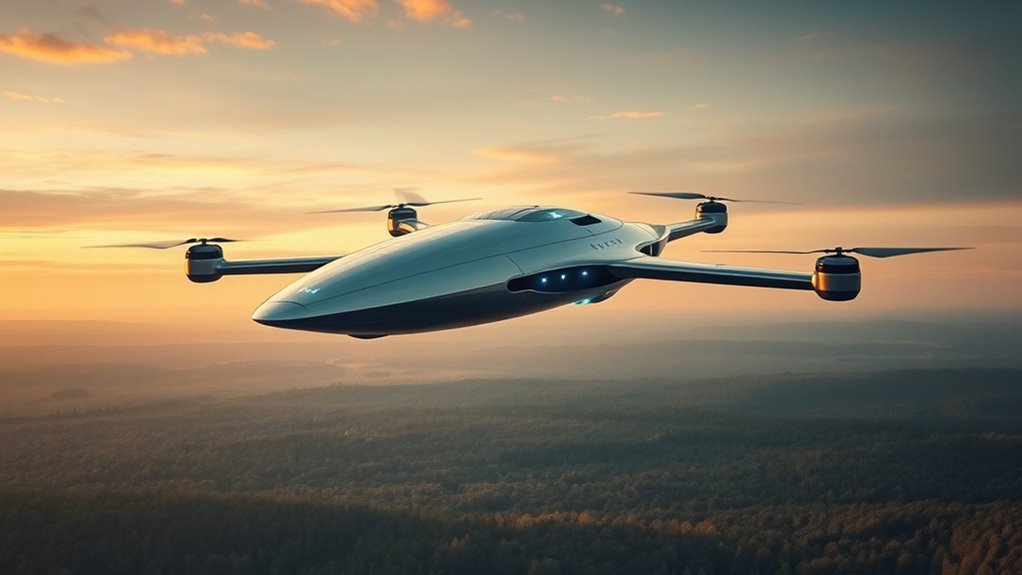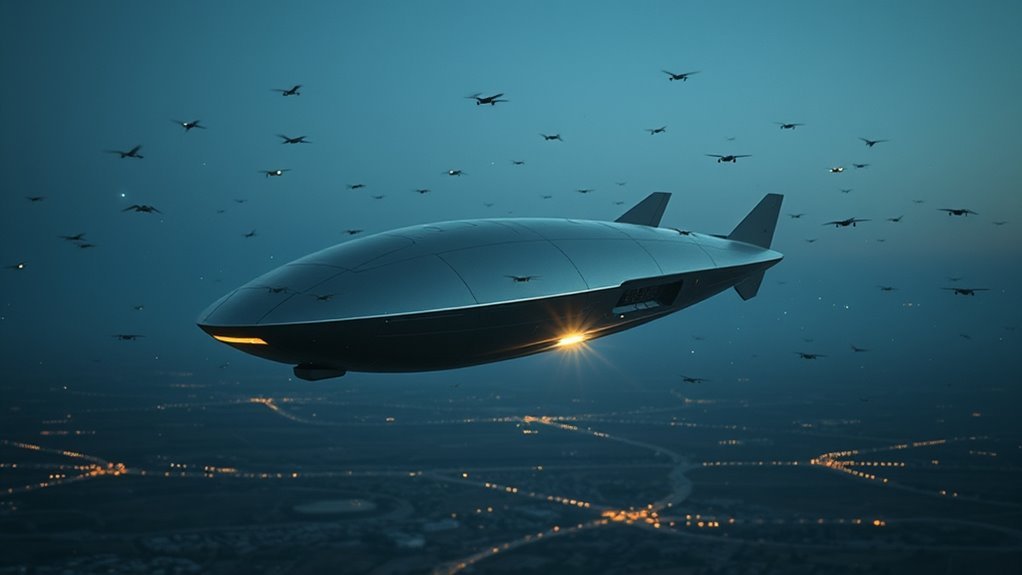A drone mothership is a large, unmanned aerial vehicle designed to serve as a base for deploying smaller drones. It enhances operational range, payload capacity, and mission versatility through advanced technologies and centralized operations. By streamlining drone coordination, it improves efficiency in military, search and rescue missions, and commercial delivery services. With continued advancements on the horizon, you’ll discover how these innovations will shape the future of drone operations and address existing challenges.
Definition of Drone Motherships

Drone motherships refer to large, unmanned aerial vehicles (UAVs) designed to serve as a base for smaller drones. These platforms greatly enhance drone capabilities by extending operational range, payload capacity, and mission versatility. Mothership designs incorporate advanced technologies, including autonomous navigation systems, communication links, and energy-efficient propulsion. By coordinating multiple smaller drones, these motherships can conduct complex tasks, from surveillance to cargo transport, while maintaining a strategic advantage. The modular nature of their designs allows for easy upgrades, ensuring adaptability in rapidly evolving environments. For individuals seeking freedom in technological application, understanding the potential of drone motherships highlights their role in redefining aerial operations, pushing boundaries of capability, and enabling innovative solutions in various sectors.
How Drone Motherships Operate

To understand how drone motherships operate, you need to examine their navigation systems, which guarantee precise positioning and route planning. You’ll also want to take into account how these systems facilitate the deployment of drones for various missions. Finally, effective communication protocols are essential for maintaining coordination between the mothership and its drones.
Mothership Navigation Systems
While traversing complex environments, a mothership’s navigation system utilizes advanced technologies to coordinate and control multiple drones effectively. Central to this functionality are sophisticated navigation algorithms, designed to optimize flight paths and enhance situational awareness. These algorithms integrate data from sensors, GPS, and real-time analytics, ensuring precise positioning and obstacle avoidance.
The mothership design plays an essential role, providing a stable platform equipped with high-performance computing capabilities to process vast amounts of information rapidly. This synergy between navigation algorithms and mothership design enables seamless communication between the mothership and its drones, fostering autonomy and operational efficiency. As you explore the capabilities of drone motherships, you’ll appreciate how these systems empower freedom in complex operational landscapes.
Deployment of Drones
As the mothership prepares for a mission, it deploys drones in a methodical manner, ensuring each unit is optimized for its specific task. Utilizing advanced drone deployment strategies, the mothership assesses environmental conditions and mission parameters to determine the most effective launch sequence. Autonomous launch systems facilitate swift and precise releases, minimizing human intervention. Each drone, equipped with specialized sensors and payloads, can perform reconnaissance, surveillance, or logistical support, depending on its designated role. This strategic deployment not only enhances operational efficiency but also allows for real-time adjustments based on unfolding scenarios. By leveraging these technologies, you’re empowered to explore and execute complex missions with unprecedented freedom and effectiveness, maximizing the potential of each drone in the fleet.
Communication Protocols Used
Effective communication protocols are crucial for the seamless operation of drone motherships, guaranteeing that each drone operates in harmony with the fleet. You’ll find that these protocols adhere to established communication standards, allowing for reliable data transmission among drones and the mothership. This interconnectivity is essential for monitoring positions, executing commands, and relaying sensor data in real-time. Systems like Wi-Fi, LTE, or even proprietary radio frequencies facilitate this exchange, enabling drones to respond swiftly to changing conditions. Furthermore, robust error-checking mechanisms guarantee data integrity, preventing miscommunications that could jeopardize missions. As you explore drone mothership technology, understanding these communication protocols will empower you to appreciate the intricacies involved in maintaining operational freedom and efficiency within the drone fleet.
Advantages of Using Drone Motherships

When considering the deployment of drone motherships, one can’t overlook the significant advantages they offer in operational efficiency and scalability. By centralizing drone operations, you achieve efficiency improvement through streamlined coordination and reduced downtime. This not only enhances mission effectiveness but also allows for rapid response to dynamic conditions, keeping you agile in various scenarios. Furthermore, the use of motherships leads to operational cost saving; fewer ground resources are required for maintenance and deployment. You can extend the operational range of drones without increasing logistical burdens. Additionally, these systems provide better data collection and communication capabilities, maximizing the potential of each drone unit. Embracing drone motherships ultimately empowers you to optimize resources and enhance operational effectiveness.
Applications in Military Operations
In military operations, drone motherships serve critical functions in both surveillance and logistics. They enhance reconnaissance capabilities by deploying smaller drones that gather real-time intelligence without exposing personnel to danger. Additionally, these motherships streamline supply support, ensuring that essential resources reach remote units efficiently and effectively. Furthermore, they enable real-time aerial surveillance to monitor enemy movements and assess battlefield conditions, which is crucial for strategic planning.
Surveillance and Reconnaissance Missions
As advancements in drone technology evolve, military operations increasingly leverage drone motherships for surveillance and reconnaissance missions. These motherships serve as strategic platforms, enhancing the effectiveness of operations through sophisticated surveillance techniques and reconnaissance strategies.
- Real-time Data Collection: Drone motherships can deploy multiple drones to gather real-time intelligence, providing commanders with actionable insights.
- Extended Range: They extend operational range, allowing for deep penetration into enemy territory without risking manned assets.
- Coordinated Operations: Motherships enable the coordination of various drones, optimizing mission effectiveness and minimizing response times.
Logistics and Supply Support
Drone motherships have become pivotal in enhancing logistics and supply support during military operations. By acting as mobile command centers, they streamline your supply chain processes, ensuring that critical resources reach the front lines efficiently. These systems enable real-time inventory management, allowing you to track supplies, munitions, and equipment dynamically. With advanced sensors and communication capabilities, drone motherships can identify shortages and redirect drones to resupply units as needed, minimizing delays. They also reduce the risk of human casualties by automating supply runs in hostile environments. This innovative approach to logistics not only increases operational effectiveness but also enhances mission flexibility, ensuring that you maintain a tactical advantage in complex scenarios.
Role in Search and Rescue Missions
When emergencies arise in remote or hazardous environments, the integration of a drone mothership can greatly enhance search and rescue operations. Utilizing advanced technology, you can improve search techniques and streamline rescue coordination. Here’s how:
- Extended Range: A drone mothership can deploy multiple drones over vast areas, reaching locations that are difficult or dangerous for human teams.
- Real-Time Data: Equipped with sensors and cameras, drones relay critical information back to command centers, aiding in quick decision-making.
- Automated Operations: Drones can autonomously execute pre-defined search patterns, ensuring thorough coverage and reducing the risk to human responders.
Impact on Commercial Delivery Services
The advancements in drone technology are reshaping various industries, including commercial delivery services. Drone logistics is becoming a game-changer in how goods are transported. By employing drone motherships, companies can enhance delivery efficiency considerably. These systems allow for centralized launching and charging of multiple drones, optimizing routes and reducing operational costs. As a result, you’re looking at faster delivery times and the ability to reach remote areas previously deemed unviable. Furthermore, integrating drone motherships into existing delivery networks provides flexibility, allowing businesses to scale operations rapidly. This innovation not only meets consumer demand for quicker service but also supports a more sustainable delivery model, reducing carbon footprints associated with traditional transportation methods. Overall, it’s revolutionizing the logistics landscape. Additionally, advanced navigation systems in drones can further optimize flight paths, ensuring efficient and timely deliveries across various terrains. The incorporation of AI-powered obstacle detection technologies enhances the safety of operations, allowing drones to navigate complex urban environments with greater agility.
Future Trends in Drone Mothership Technology
As advancements continue to emerge in drone technology, the future of mothership systems holds promising potential for various applications. You’ll likely see significant trends in this area, particularly with the integration of autonomous systems and aerial robotics. Here are three key trends to watch:
- Enhanced Autonomy: Motherships will increasingly leverage AI for real-time decision-making, improving operational efficiency.
- Swarm Technology: Coordinated fleets of drones will work together, allowing for complex missions and coverage over vast areas.
- Expanded Payload Capabilities: Future motherships will support diverse payloads, enabling versatile applications from surveillance to disaster response. Additionally, understanding drone lifespan will be crucial for optimizing the performance and longevity of these advanced systems.
These innovations will redefine how you perceive drone operations, providing unprecedented freedom and capabilities across numerous sectors.
Challenges and Limitations of Drone Motherships
While the advancements in drone mothership technology promise exciting opportunities, several challenges and limitations must be addressed. You’ll encounter technical limitations such as payload capacity and communication range. Additionally, adherence to drone registration requirements is crucial to avoid legal complications. Operational challenges also arise, including regulatory constraints and environmental factors.
| Challenge | Description | Impact on Operations |
|---|---|---|
| Technical Limitations | Limited payload and range | Restricts mission capabilities |
| Regulatory Constraints | Compliance with aviation laws | Delays deployment |
| Environmental Factors | Weather conditions affecting performance | Reduces operational effectiveness |
| Maintenance Issues | High costs and complexity of upkeep | Increases downtime |
Understanding these challenges is essential for optimizing the use of drone motherships, allowing you to navigate the complexities of this emerging technology. Additionally, advanced AI integration can help mitigate some of these challenges by improving operational efficiency and decision-making processes.
Frequently Asked Questions
Can Drone Motherships Be Used for Recreational Purposes?
Yes, you can use drone motherships for recreational purposes like drone racing or aerial photography. They enhance your experience, allowing you to explore expansive areas and capture stunning visuals, all while maintaining control and freedom.
What Are the Environmental Impacts of Drone Motherships?
When considering environmental impacts, you should note that drone motherships can contribute to drone pollution and cause wildlife disturbance, potentially disrupting ecosystems. Responsible usage is essential to mitigate these negative effects while enjoying their functionalities.
How Do Drone Motherships Communicate With Smaller Drones?
Drone motherships utilize advanced communication protocols for effective signal transmission to smaller drones. You’ll find these protocols guarantee real-time data exchange, enabling coordinated operations and enhancing mission effectiveness while maintaining operational autonomy for each drone.
Are There Regulations Governing Drone Mothership Operations?
Yes, there’re drone regulations and operational guidelines you must follow. These rules guarantee safety and compliance, balancing your freedom to operate with the need for responsible use in shared airspace. Stay informed to avoid violations.
What Is the Cost of Developing a Drone Mothership?
Imagine a high-tech factory in the sky; developing a drone mothership can soar into the hundreds of thousands. Funding sources range from private investors to government grants, impacting overall development costs and potential innovation.

